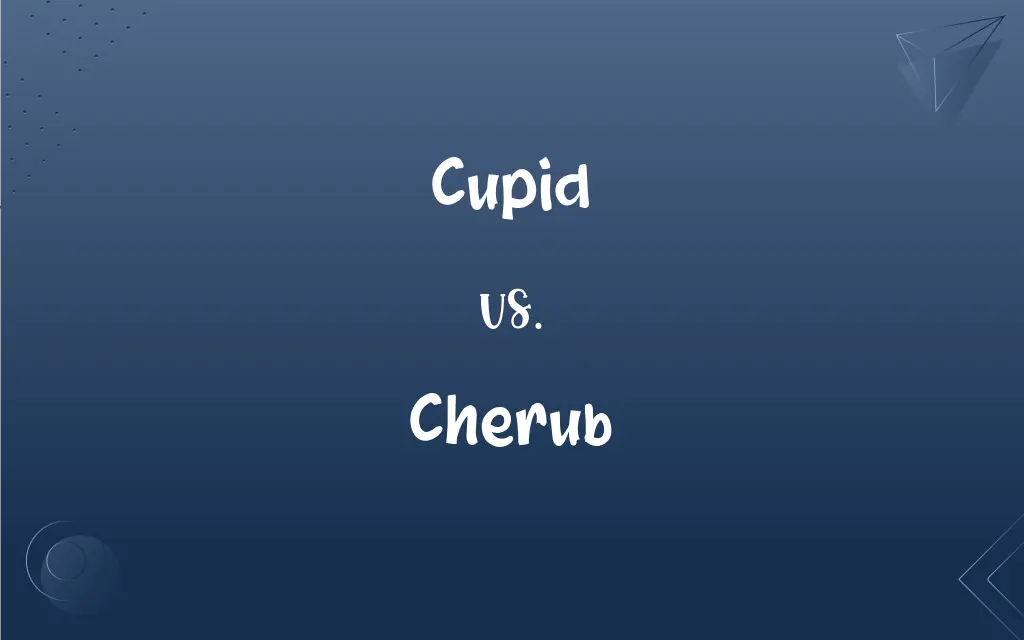Cupid vs. Cherub: What's the Difference?
By Aimie Carlson & Janet White || Updated on May 20, 2024
Cupid is the Roman god of love, often depicted as a winged child with a bow and arrows, whereas a cherub is a type of angel in Christian theology, depicted as a chubby, winged child or infant.

Key Differences
Cupid, known as Eros in Greek mythology, is the Roman god of love and desire. He is often depicted as a winged child with a bow and arrows, symbolizing his ability to make people fall in love by shooting them with his arrows. A cherub, on the other hand, is a type of angel found in Christian theology, depicted as a chubby, winged child or infant. Cherubim (plural of cherub) are considered to be angels of the second-highest order in the hierarchy of angels and are often associated with innocence and the protection of the divine.
Cupid's primary role in mythology is to incite love and desire, using his arrows to influence the emotions and actions of gods and mortals alike. He is often featured in myths and artworks that emphasize romantic and erotic love. Cherubs, in contrast, are more symbolic of purity, innocence, and divine protection. They are often depicted in religious art, especially during the Renaissance, as plump, childlike angels with wings, reflecting their roles as guardians of the sacred.
While Cupid is a figure from classical mythology with a specific narrative and personality, cherubs are more generalized figures in religious iconography without individual stories. They serve more as symbols of divine presence and protection.
Cupid's imagery is rooted in the classical traditions of Greek and Roman art, focusing on themes of love and desire. Cherubs' imagery, however, is more prominent in Christian art and is used to convey themes of divinity, innocence, and heavenly protection.
Comparison Chart
Origin
Roman mythology (Eros in Greek)
Christian theology
ADVERTISEMENT
Depiction
Winged child with bow and arrows
Chubby, winged child or infant
Role
God of love and desire
Angel symbolizing innocence, protection
Symbolism
Romantic and erotic love
Purity, divine presence
Cultural Context
Classical mythology and art
Religious art, especially Renaissance
Cupid and Cherub Definitions
Cupid
Associated with romantic love and Valentine's Day.
Valentine cards often feature images of Cupid.
ADVERTISEMENT
Cherub
Considered angels of the second-highest order.
In religious texts, cherubim are often seen near the throne of God.
Cupid
Often depicted as a winged child with a bow and arrows.
The statue of Cupid stood in the garden, holding his bow.
Cherub
Depicted as a chubby, winged child or infant.
The cherub's serene face brought a sense of peace to the artwork.
Cupid
Known for shooting arrows to incite love.
In the myth, Cupid shot Apollo with a golden arrow.
Cherub
A type of angel in Christian theology.
The church ceiling was adorned with paintings of cherubs.
Cupid
Roman god of love and desire.
Cupid's arrow made them fall deeply in love.
Cherub
Symbolizes innocence and divine protection.
The cherubim on the altar represented guardians of the sacred space.
Cupid
Sometimes mischievous in mythology.
Cupid's antics often caused chaos among the gods.
Cherub
Prominent in Renaissance religious art.
Renaissance artists frequently painted cherubs in their works.
Cupid
Roman Mythology The god of love; the son of Venus.
Cherub
A winged celestial being.
Cupid
Cupid A representation of Cupid as a naked cherubic boy usually having wings and holding a bow and arrow, used as a symbol of love.
Cherub
Cherubim(Christianity) The second of the nine orders of angels in medieval angelology.
Cupid
A putto carrying a bow and arrow, representing Cupid or love.
Cherub
A putto.
Cupid
Any of various lycaenid butterflies of the genera Chilades, Cupido and Everes.
Cherub
A person, especially a child, with an innocent or chubby face.
Cupid
The god of love, son of Venus; usually represented as a naked, winged boy with bow and arrow.
Pretty dimpled boys, like smiling cupids.
Cherub
(biblical) A winged creature attending God, described by Pseudo-Dionysius the Areopagite (short=yes) as the second highest order of angels, ranked above thrones and below seraphim; similar to a lamassu in the pre-exilic texts of the Hebrew Bible, more humanoid in later texts.
Cupid
(Roman mythology) god of love; counterpart of Greek Eros
Cherub
An artistic depiction of such a being, typically in the form of a winged child or a child's head with wings but no body.
Cherub
(figuratively) A person, especially a child, seen as being particularly angelic or innocent.
Cherub
A mysterious composite being, the winged footstool and chariot of the Almighty, described in Ezekiel i. and x.
I knew that they were the cherubim.
He rode upon a cherub and did fly.
Cherub
A symbolical winged figure of unknown form used in connection with the mercy seat of the Jewish Ark and Temple.
Cherub
One of a order of angels, variously represented in art. In European painting the cherubim have been shown as blue, to denote knowledge, as distinguished from the seraphim (see Seraph), and in later art the children's heads with wings are generally called cherubs.
Cherub
A beautiful child; - so called because artists have represented cherubs as beautiful children.
Cherub
A sweet innocent baby
Cherub
An angel of the second order whose gift is knowledge; usually portrayed as a winged child
FAQs
Who is Cupid?
Cupid is the Roman god of love and desire, often depicted as a winged child with a bow and arrows.
What does Cupid symbolize?
Cupid symbolizes romantic and erotic love.
Where is Cupid commonly seen?
Cupid is commonly seen in art and literature related to love and romance, especially around Valentine's Day.
What do cherubs symbolize?
Cherubs symbolize innocence, purity, and divine protection.
What is a cherub?
A cherub is a type of angel in Christian theology, depicted as a chubby, winged child or infant.
What is a common representation of Cupid in modern culture?
A common representation of Cupid in modern culture is a small, winged child with a bow, associated with Valentine's Day.
Does Cupid have a specific mythological story?
Yes, Cupid has many stories, including the famous tale of Cupid and Psyche.
Are Cupid and Eros the same?
Yes, Cupid is the Roman counterpart of the Greek god Eros.
Where are cherubs commonly depicted?
Cherubs are commonly depicted in religious art, especially in churches and Renaissance paintings.
What role do cherubs play in Christian art?
Cherubs in Christian art often symbolize the presence and protection of the divine.
Do cherubs have individual stories?
Cherubs are more symbolic and do not have individual stories like mythological gods.
Is Cupid considered mischievous?
Yes, Cupid is often portrayed as mischievous in myths, causing unexpected love affairs.
Can cherubs be found in non-religious art?
Yes, cherubs can also be found in non-religious art as symbols of innocence and beauty.
What are some famous artworks featuring Cupid?
Famous artworks include "Cupid and Psyche" by Antonio Canova and "The Birth of Venus" by Sandro Botticelli.
Do cherubs always have a chubby appearance?
Yes, cherubs are typically depicted as chubby, winged children.
What are Cupid's arrows used for?
Cupid's arrows are used to incite love and desire in those he shoots.
What hierarchy do cherubs belong to?
Cherubs belong to the second-highest order of angels in Christian theology.
Are cherubs only found in Christianity?
While primarily in Christian theology, similar angelic figures appear in other religions and mythologies.
What are some famous artworks featuring cherubs?
Famous artworks include Raphael's cherubs in the "Sistine Madonna" and numerous Renaissance church frescoes.
Does Cupid always have wings?
Yes, Cupid is typically depicted with wings.
About Author
Written by
Aimie CarlsonAimie Carlson, holding a master's degree in English literature, is a fervent English language enthusiast. She lends her writing talents to Difference Wiki, a prominent website that specializes in comparisons, offering readers insightful analyses that both captivate and inform.
Co-written by
Janet WhiteJanet White has been an esteemed writer and blogger for Difference Wiki. Holding a Master's degree in Science and Medical Journalism from the prestigious Boston University, she has consistently demonstrated her expertise and passion for her field. When she's not immersed in her work, Janet relishes her time exercising, delving into a good book, and cherishing moments with friends and family.































































